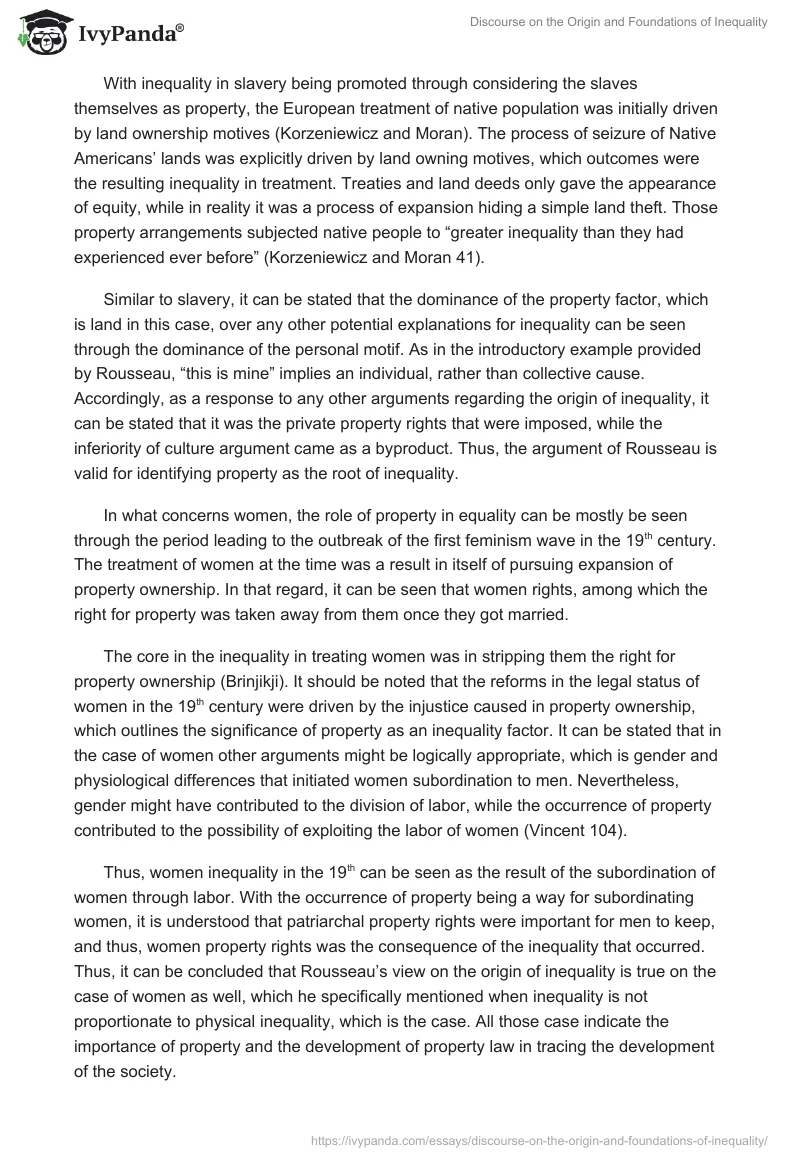In his famous work “What is the Origin of Inequality among Men “, John-Jacques Rousseau stated that the foundation of a civil society is based on the principle of property ownership. The simplification of such foundation, saying This is Mine, is nothing more than simplified representation, not only of the way civil society is built, but also of the root of moral inequality in such society (Rousseau).
Furthermore, Rousseau emphasizes that such inequality was advanced through the establishment of laws and regulations that protected property laws. Analyzing manifestations of inequality in the way Europeans treatment of Native people, the treatment of women, and slavery, Rousseau’s conclusion cannot be agreed with more. Thus, this paper states that property surpassed any other reason in either creating or prolonging inequality in society.
Slavery as an example of inequality caused by property is unique in that not property owning was the main case per se, rather than the fact that the slaves were treated as property. In that regard, inequality in the conditions of antebellum slavery might be traced back to the time black people were enslaved in Africa. Although scientific literature of the time established the inequality in race assumptions, it can be argued that the right for such arguments to be considered valid was given through property ownership differences. In that regard, the need for labor to manage property was contributing factor to sustain slavery (Lowance 2).
Accordingly, even within freed slaves, enjoying other rights, e.g. the rights to vote, was preconditioned by owning property, a right which black people were also stripped of (Lowance 4). The argument of property contributing for the advancement of slavery can be agreed with as the dominant one, where as opposed to economic advancement, it served as the cause, rather than the outcome. Thus, those arguing that slavery might have been promoted for the sake of economic advancement of the south, it can be stated that it was the impact on property that initiated the slavery and inequality subsequently, while economic advancement came as a side-effect.
With inequality in slavery being promoted through considering the slaves themselves as property, the European treatment of native population was initially driven by land ownership motives (Korzeniewicz and Moran). The process of seizure of Native Americans’ lands was explicitly driven by land owning motives, which outcomes were the resulting inequality in treatment. Treaties and land deeds only gave the appearance of equity, while in reality it was a process of expansion hiding a simple land theft. Those property arrangements subjected native people to “greater inequality than they had experienced ever before” (Korzeniewicz and Moran 41).
Similar to slavery, it can be stated that the dominance of the property factor, which is land in this case, over any other potential explanations for inequality can be seen through the dominance of the personal motif. As in the introductory example provided by Rousseau, “this is mine” implies an individual, rather than collective cause. Accordingly, as a response to any other arguments regarding the origin of inequality, it can be stated that it was the private property rights that were imposed, while the inferiority of culture argument came as a byproduct. Thus, the argument of Rousseau is valid for identifying property as the root of inequality.
In what concerns women, the role of property in equality can be mostly be seen through the period leading to the outbreak of the first feminism wave in the 19th century. The treatment of women at the time was a result in itself of pursuing expansion of property ownership. In that regard, it can be seen that women rights, among which the right for property was taken away from them once they got married.
The core in the inequality in treating women was in stripping them the right for property ownership (Brinjikji). It should be noted that the reforms in the legal status of women in the 19th century were driven by the injustice caused in property ownership, which outlines the significance of property as an inequality factor. It can be stated that in the case of women other arguments might be logically appropriate, which is gender and physiological differences that initiated women subordination to men. Nevertheless, gender might have contributed to the division of labor, while the occurrence of property contributed to the possibility of exploiting the labor of women (Vincent 104).
Thus, women inequality in the 19th can be seen as the result of the subordination of women through labor. With the occurrence of property being a way for subordinating women, it is understood that patriarchal property rights were important for men to keep, and thus, women property rights was the consequence of the inequality that occurred. Thus, it can be concluded that Rousseau’s view on the origin of inequality is true on the case of women as well, which he specifically mentioned when inequality is not proportionate to physical inequality, which is the case. All those case indicate the importance of property and the development of property law in tracing the development of the society.
Analyzing cases of inequality in antebellum south, women’s right, and native populations, it can be concluded that in all those cases property was a contributing factor. Such finding supports Rousseau’s view on inequalities as owing their strength to the establishment of property. Rousseau’s view on inequality outlines property and supporting legislative framework as the root of institutionalizing abuse in the society.
Works Cited
Brinjikji, Hiam. “Property Rights of Women in Nineteenth-Century England”. n.d. University of Michigan-Dearborn. 2011. Web.
Korzeniewicz, Roberto Patricio, and Timothy Patrick Moran. Unveiling Inequality : A World-Historical Perspective. New York: Russell Sage Foundation, 2009. Print.
Lowance, Mason I. A House Divided : The Antebellum Slavery Debates in America, 1776-1865. Princeton, NJ: Princeton University Press, 2003. Print.
Rousseau, Jean Jacques. “What Is the Origin of Inequality among Men, and Is It Authorised by Natural Law?”. 1754. Constitution Society. 2011. Web.
Vincent, John A. Inequality and Old Age. New York, N.Y.: St. Martin’s Press, 1995. Print.


